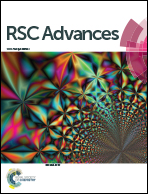A facile one-step spray-coating process for the fabrication of a superhydrophobic attapulgite coated mesh for use in oil/water separation†
Abstract
Oil/water separation is a worldwide problem due to the increasing emission of industrial oily waste water and the frequent oil spill accidents. Herein, we demonstrate, for the first time, superhydrophobic attapulgite coated mesh films for gravity driven oil water separation, which were fabricated by a facile one-step spray-coating process. The as-prepared attapulgite coated mesh films show both superhydrophobic and superoleophilic properties simultaneously with a high water contact angle of 155° ± 1° and an oil contact angle of 0°. Thus, they can be used to separate a series of oil/water mixtures, such as kerosene, chloroform, and petroleum ether with separation efficiency up to 97% for the kerosene/water mixture. In addition, the as-prepared coated mesh still maintained separation efficiency above 94% and stable recyclability after 40 separation cycles with the surface morphology of the attapulgite coated mesh nearly unchanged. Besides, the separation mechanism for the oil/water mixture was elaborated by interpreting the different states of water droplet on the surface before and during separation, which has been discussed scarcely. Furthermore, the as-prepared attapulgite coated mesh could keep its superhydrophobic property under various harsh conditions, not only for pure water but also for corrosive acidic, alkaline and salt solutions, which suggests attractive potential for practical oil/water separation in industry and everyday life.


 Please wait while we load your content...
Please wait while we load your content...